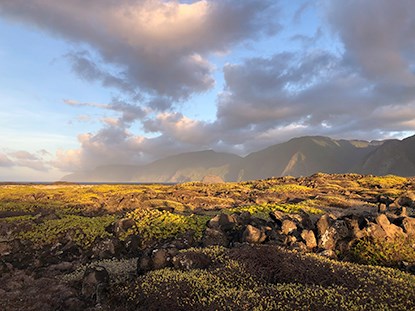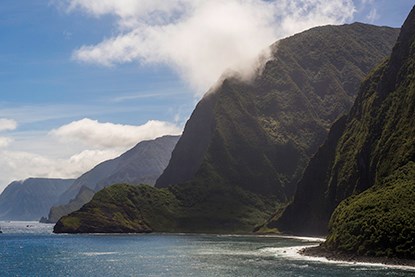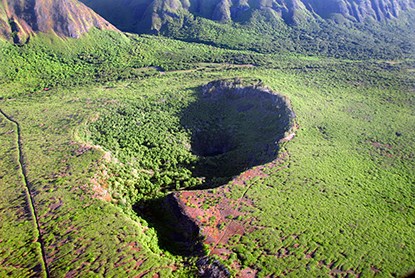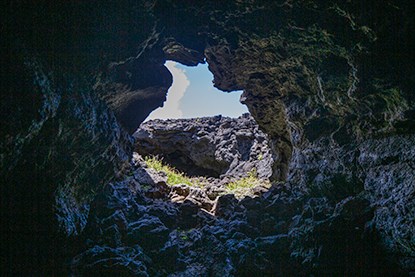|
Kalaupapa National Historical Park protects habitats ranging from the ocean to the upland rain forest. The park’s boundary extends for a quarter mile offshore and includes 2,000 acres of ocean, two small islands and wet shorelines. All support a wealth of fish and wildlife resources. Over 30 federally-listed threatened and endangered species of plants and animals have been identified within the park. 
Photo by Ken Wood, National Tropical Garden. Loulu Palm ForestsSediment cores from widespread archaeology studies show that loulu palm forests predominated in Hawaii's prehistoric lowlands. Polynesian colonists arriving in about 300 AD introduced new competing plants, the Polynesian rat, and cleared and burned these native forests for agriculture. Thereafter the endemic palm forests went into steep decline. Today they survive intact only on this tiny Huelo Islet near Kalaupapa's east boarder. The island is far enough from the coastline of Moloka'i to keep the loulu palms safe from rats that eat the seeds and alien competing plants. Huelo Island cannot be visited, but it can be viewed from Judd Park in Kalawao. 
NPS / Hailey Shchepanik Coastal Spray ZoneThe coastal spray zone, located along the northeast shore of the peninsula, contains predominantly native plant communities. This habitat contains several federally endangered plants including the endemic haha, and alani. The endangered Carter's Panic grass can be found on the Kuka`iwa`a Peninsula. Native Hawaiian vegetation in the coastal spray zone includes `illima, hinahina, and naupaka. 
NPS photo / Michael Langhans Na PaliNa pali, or sea cliffs, rising thousands of feet above the peninsula and ocean, separate the peninsula from the rest of the island of Moloka`i. Native vegetation such as `awikiwiki, and makou survives here because of the relative inaccessibility. Hala trees are native to Hawai`i and can grow from the shorelines to 1,000 foot elevation on the cliffs. This area has been designated as the North Shore Cliffs National Natural Landmark (1972), recognized as a significant remaining example of sea cliffs in the nation’s natural heritage. 
NPS / Rob Ratkowski Kauhakō CraterUnique and native species can also be found within Kauhakō Crater. Endemic `ohe makai and wiliwili forest in the crater is the only remaining windward coast community of its type, low elevation dryland forest, known in the state of Hawai`i. A lake at the bottom of the crater, less than one acre in surface area, is more than 800 feet deep and contains a sub-species of shrimp, which may be unique to this lake. 
NPS / Shaun Wolfe Waikolu ValleyWaikolu Valley contains the park's sole perennial, or ever-flowing, stream, and one of only four such streams on the entire island of Moloka`i. The stream contains all five native diadromous (goby) fish species, native snails and shrimp. Surface and groundwater withdrawn from Waikolu is the source of most water for the entire western half of Moloka`i. Pu`u Ali`i-`Ohi`alele Plateau, on top the cliffs to the east of Waikolu Valley, is one of the best examples of `ohi`a rain forest in Hawai`i. It provides essential habitat for rare native forest birds, including the `Amakihi, `Apapane, and the `I`iwi. In this intact native forest are varieties of ferns and peperomia. 
NPS / Michael Langhans Lava TubesTwenty known lava tubes and caves on the peninsula contain endemic invertebrate species and as yet incompletely inventoried flora and fauna. The Kauhako Trench, a collapsed lava tube about one mile in length and running north from Kauhako Crater, contains vegetation established in an environment protected from wind and ocean spray as well as browsing and trampling by deer, pigs, horses, and at one time, cattle. |
Last updated: December 5, 2022
